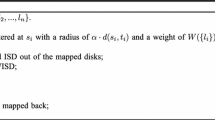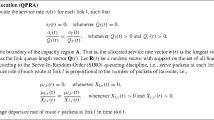Abstract
Proportional fairness is a widely accepted form of allocating transmission resources in communication systems. For wired networks, the combination of a simple probabilistic packet marking strategy together with a scheduling algorithm aware of two packet classes can meet a given proportional vector of n loss probabilities, to an arbitrary degree of approximation, as long as the packet loss gap between the two basic classes is sufficiently large. In contrast, for wireless networks, proportional fairness is a challenging problem because of random channel variations and contention for transmitting. In this paper, we show that under the physical model, i.e., when receivers regard collisions and interference as noise, the same packet marking strategy at the network layer can also yield proportional differentiation and nearly optimal throughput. Thus, random access or interference due to incoherent transmissions do not impair the feasibility of engineering a prescribed end-to-end loss-based proportional fairness vector. We consider explicitly multihop transmission and the cases of Markovian traffic with a two-priority scheduler, as well as orthogonal modulation with power splitting. In both cases, it is shown that sharp differentiation in loss probabilities at the link layer is achievable without the need to coordinate locally the transmission of frames or packets among neighboring nodes. Given this, a novel distributed procedure to adapt the marking probabilities so as to attain exact fairness is also developed. Numerical experiments are used to validate the design.





Similar content being viewed by others
Notes
This can be easily done in a number of ways, such as priority queueing, capacity allocation or fair queueing, and it is not a major concern in the paper.
Collisions may also be harmless if the receiver is capable of multipacket reception. We do not consider this possibility.
References
Argibay-Losada, P. J., Suárez-González, A., López-García, C., & Fernández-Veiga, M. (2010). A new design for end-to-end proportional loss differentiation in IP networks. Computer Networks, 54(9), 1389–1403.
Banchs, A., Serrano, P., & Vollero, L. (2007). Proportional fair throughput allocation for multirate 802.11e EDCA wireless LANs. Wireless Networks, 13(5), 649–662.
Biglieri, E., Proakis, J., Shamai(Shitz), S. (1998). Fading channels: Information-theoretic and communications aspects. IEEE Transactions on Information Theory, 44(6), 2619–2692.
Boche, H., & Schubert, M. (2009). Nash bargaininh and proportional fairness for wireless systems. IEEE/ACM Transactions on Networking, 17(5), 1453–1466.
Cheng, H. T., & Zhang, W. (2008). An optimization framework for balancing throughput and fairness in wireless networks with QoS support. IEEE Transactions on Wireless Communications, 7(7), 584–593.
Cohen, J. E. (1979). Random evolutions and the spectral radius of a nonnegative matrix. Mathematical Proceedings of the Cambridge Philosophical Society., 86, 345–350.
Dovrolis, C., Stiliadis, D., & Ramanathan, P. (2002). Proportional differentiated services: Delay differentiation and packet scheduling. IEEE/ACM Transactions on Networking, 10(1), 12–26.
Elwalid, A. I., & Mitra, D. (1993). Effective bandwidth of general Markovian sources and admission control of high speed networks. IEEE/ACM Trans. Networking, 1(3), 329–343.
El Gamal, A., & Kim, Y. H. (2011). Network information theory. Cambridge: Cambridge University Press.
Gantmacher, F. R. (1960). The theory of matrices, (2 edn.). New York: Chelsea.
Georgiadis, L., Neely, M. J., & Leandros, T. (2006). Resource allocation and cross layer control in wireless networks. Foundations and trends in networking, Vol. 1. Hanover: Now Publishers.
Gupta, P., & Kumar, P. R. (2000). The capacity of wireless networks. IEEE Transaction on Information Theory, 33(2), 388–404.
Jiang, L., Leconte, M., Ni, J., Srikant, R., & Walrand, J. (2012). Fast mixing of parallel glauber dynamics and low-delay CSMA scheduling. IEEE Transaction on Information Theory, 58(10), 6541–6555.
Kelly, F. P., Maulloo, A., & Tan, D. (1998). Rate control for communication networks: Shadow prices, proportional fairness and stability. Journal of the Operational Research, 49(3), 237–252.
Kunniyur, S., & Srikant, R. (2003). End-to-end congestion control: Utility functions, random losses and ECN marks. IIEEE/ACM Transactions on Networking, 11(5), 689–702.
Liu, J., Stolyar, A. L., Chiang, M., & Poor, H. V. (2009). Queue back-pressure random access in multihop wireless networks: Optimality and stability. IEEE Transaction on Information Theory, 55(9), 4087–4099.
Lu, S., Bharghavan, B., & Srikant, R. (1999). Fair scheduling in wireless packet networks. IEEE/ACM Transactions on Networking, 7(4), 473–489.
Laurent, M. (2007). Structural properties of proportional fairness: Stability and insensitivity. The Annals of Applied Probability, 17(3), 809–839.
Menache, I., & Shinkin, N. (2008). Capacity management and equilibrium for proportional QoS. IEEE/ACM Transactions on Networking, 16(5), 1025–1037.
Mushkin, M., & Bar-David, I. (1989). Capacity and coding for the gilbert-elliott channels. IEEE Transaction on Information Theory, 35(6), 1277–1290.
Neely, M. J., Modiano, E., & Li, C. (2005). Fainess and optimal stochastic control for heterogeneous networks. In Proceedings on IEEE INFOCOM, Vol. 3, pp. 1723–1734.
Padhye, J., Firoiu, J., Towsley, D. F., & Kurose, J. F. (2000). Modeling TCP Reno performance: A simple model and its empirical validation. IEEE/ACM Transactions on Networking, 8(2), 133–145.
Stiliadis, D., & Varma, A. (1998). Rate-proportional servers: A design methodology for fair queueing algorithms. IEEE/ACM Transactions on Networking, 6(2), 164–174.
Subramanian, V., Duffy, K., & Leith, D. (2009). Existencee and uniqueness of fair rate allocations in lossy wireless networks. IEEE Transactions on Wireless Communications, 8(7), 3401–3406.
Tse, D., & Viswanath, P. (2005). Fundamentals of wireless communications. Cambridge: Cambridge University Press.
Tulino, A. M., Caire, G., Shamai, S., & Verdú, S. (2010). Capacity of channels with frequency-selective and time-selective fading. IEEE Transaction on Information Theory, 56(3), 1187–1215.
Verdú, S., & Han, T. S. (1994). A general formula for channel capacity. IEEE Transaction on Information Theory, 40(4), 1147–1157.
Wang, P., Jiang, H., Zhang, W., & Poor, H. V. (2009). Redefinition of max-min fairness in mutlihop wireless networks. IEEE Transactions on Wireless Communications, 7(12), 4786–4791.
Zhang, Y. J., & Chan Liew, S. (2008). Proportional fairness in multi-channel multi-rate wireless networks–Part ii: the case of time-varying channels with application to OFDM systems. IEEE Transactions on Wireless Communications, 7(9), 3457–3467.
Zwillinger, D. (1997). Handbook of differential equations, chapter Lyapunov functions, (3 edn.). Boston, MA: Academic Press.
Acknowledgments
This work was supported by the Ministerio Ciencia e Innovación, under Grant TEC2009-12135, and is also partially funded by the EU under the FEDER program.
Author information
Authors and Affiliations
Corresponding author
Appendices
Appendix 1: Proof of Theorem 2
The proof of the theorem is based on certain results about nonnegative matrices and its eigenvalues. We begin by recalling the relevant properties. A real matrix is called essentially nonnegative if its off-diagonal elements are nonnegative. The maximal real eigenvalue of an essentially nonnegative, irreducible matrix is increasing when any of its elements increases [10]. Moreover, the maximal real eigenvalue of A + D, where A is any irreducible and essentially nonnegative matrix and D is diagonal with not all elements identical, is a strictly convex function of D [6]. Now, let Q be the infinitesimal generator of an irreducible Markov process, and let \(\Uplambda\) be the matrix of instantaneous arrival rates associated with that process. Solving the eigenvalue problem
is equivalent to solving
if the service rate c is regarded as a function of the eigenvalue η. We adopt in the following lemma the proper point of view for our purpose: assume η is constant and interpret g(η) as a function of the matrix \(\Uplambda\) (or, more precisely, as a function of the diagonal elements in \(\Uplambda\)).
Lemma 7
The maximal real eigenvalue g(η) of the matrix \(\Uplambda - \frac{1}{\eta} Q\) is increasing when any element of \(\Uplambda\) increases.
Proof
The steps of the proof mimic those in [8]. The matrix \(Q(\eta) = Q - \eta \Uplambda\) is essentially nonnegative. Since η < 0, increasing one of the elements in the diagonal matrix \(\Uplambda,\) say λ i , has the effect of increasing the same element in Q(η), while the others remain unchanged. So the maximal real eigenvalue of \(Q(\eta),\;\hbox{mre}(Q(\eta)),\) increases and is a convex function of λ i , too. To see this, pick two points a 1 i and a 2 i . Put \(\Uplambda_1 = \Uplambda + (a_i^1 - \lambda_i) E\) and, similarly, \(\Uplambda_2 = \Uplambda + (a_i^2 - \lambda_i) E,\) where E is a diagonal matrix with E ii = 1 and zero otherwise. By the matrix-convexity of \(\hbox{mre}(\cdot),\) using \(A_1 = Q - \eta \Uplambda_1\) and \(D = \eta(\Uplambda_1 - \Uplambda_2)\) we can write
The second and the last terms establish the strict convexity in a i . The last step of the proof begins noticing that
Using the monotonicity of \(\hbox{mre}(\cdot),\) it is straightforward to deduce that
because η is a constant independent of λ i . Since η < 0, the maximal real eigenvalue g(η) is increasing in λ i . Finally, taking the derivative of (25) and recalling the convexity of the maximal real eigenvalue, the inequality
shows that g(η) is a convex function of λ i . □
By application of the chain rule, the inverse function of g(η) is monotonically increasing in λ i and strictly concave.
Appendix 2: Proof of Lemma 3
A direct calculation suffices. Under the stated assumptions, the first derivative of
is
and the first derivative of f(x)/g(x) is
If \((f(x)/g(x))^\prime\) is asymptotically decreasing, then the numerator \(f^\prime(x) g(x) - f(x) g^\prime(x) < 0.\) Since f(x) and g(x) tend to 0 as \(x \to \infty.\) for sufficiently large x the difference \(g^\prime(x) - f^\prime(x) < \epsilon,\) for any \(\epsilon > 0.\) Using these in (27) shows that \(h^\prime(x) < 0\) for sufficiently large x.
Rights and permissions
About this article
Cite this article
Argibay-Losada, P.J., Nozhnina, K., Suárez-González, A. et al. Loss-based proportional fairness in multihop wireless networks. Wireless Netw 20, 805–816 (2014). https://doi.org/10.1007/s11276-013-0644-3
Published:
Issue Date:
DOI: https://doi.org/10.1007/s11276-013-0644-3




